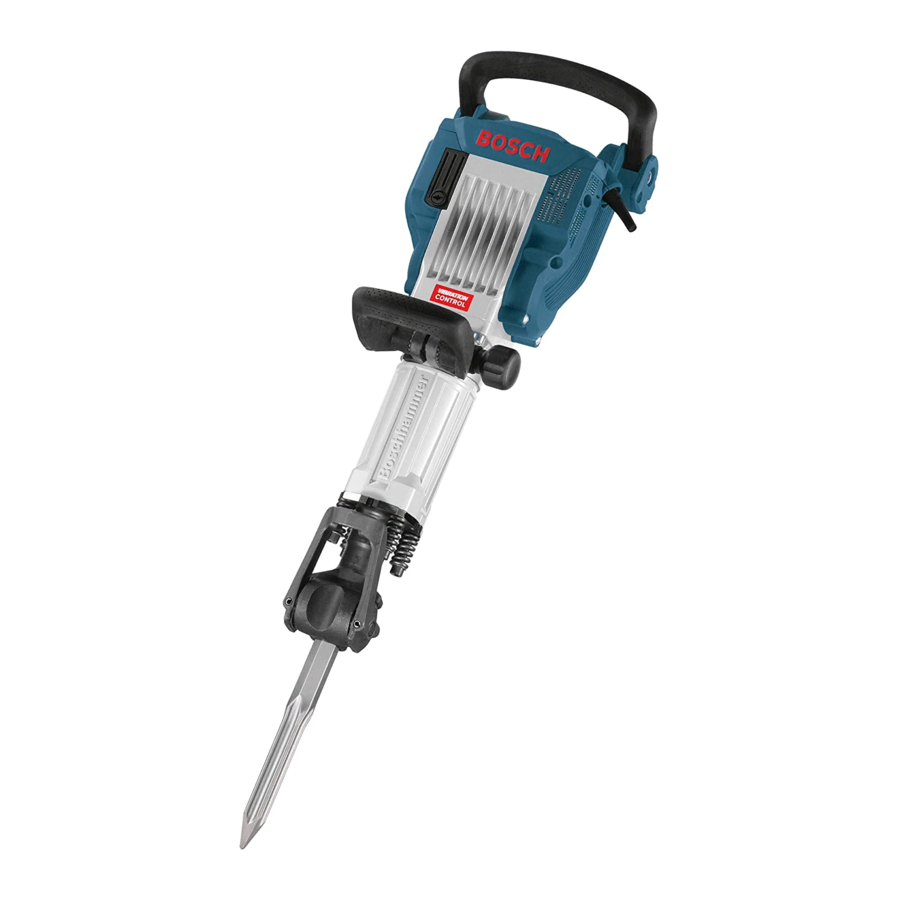Bosch 1191VSRK Betriebs-/Sicherheitshandbuch - Seite 10
Blättern Sie online oder laden Sie pdf Betriebs-/Sicherheitshandbuch für Bohrer Bosch 1191VSRK herunter. Bosch 1191VSRK 37 Seiten. Bosch power tools hammer & hammer drill brochure
Auch für Bosch 1191VSRK: Kurzreferenz-Handbuch (25 seiten)

BM 160992A08A 01-13_BM 160992A08A 01-13.qxp 1/10/13 2:44 PM Page 10
FASTENING WITH SCREWS
The procedure shown in (Fig. 7) will enable
you to fasten materials together with your
hammer drill in the drill mode without
stripping, splitting or separating the material.
First, clamp the pieces together and drill the
first hole 2/3 the diameter of the screw. If the
material is soft, drill only 2/3 the proper
length. If it is hard, drill the entire length.
Second, unclamp the pieces and drill the
second hole the same diameter as the screw
shank in the first or top piece of wood.
Third, if flat head screw is used, countersink
the hole to make the screw flush with the
surface. Then, simply apply even pressure
when driving the screw. The screw shank
clearance hole in the first piece allows the
screw head to pull the pieces tightly together.
The adjustable screw drill accessory will do
all of these operations quickly and easily.
DRILL BITS
Always inspect drill bits for excessive wear. Use
only bits that are sharp and in good condition.
TWIST BITS: Available with straight and
reduced shanks for wood and light duty metal
drilling. High speed bits cut faster and last
longer on hard materials.
CARBIDE TIPPED BITS: Used for drilling
stone, concrete, plaster, cement and other
unusually hard nonmetals. Use continuous
heavy feed pressure when employing carbide
tip bits.
DRILLING WOOD
Be certain workpiece is clamped or anchored
firmly. Always apply pressure in a straight line
with the drill bit. Maintain enough pressure to
keep the drill "biting".
When drilling holes in wood, twist bits can be
used. Twist bits may overheat unless pulled out
frequently to clear chips from flutes.
Use a "back-up" block of wood for work that is
likely to splinter, such as thin materials.
You will drill a cleaner hole if you ease up on
the pressure just before the bit breaks through
the wood. Then complete the hole from the
back side.
Screw drills are available for screw sizes No.
6, 8, 10 and 12.
FASTENING WITH
SCREWS
1. Drill 2/3 diameter and
2/3 of screw length for
soft materials, full
length for hard
materials.
Screw
Apply a slight
even pressure
when driving
screws.
DRILLING METAL
There are two rules for drilling hard materials.
First, the harder the material, the greater the
pressure you need to apply to the tool. Second,
the harder the material, the slower the speed.
Here are a couple of tips for drilling in metal.
Lubricate the tip of the bit occasionally with
cutting oil except when drilling soft metals such
as aluminum, copper or cast iron. If the hole to
be drilled is fairly large, drill a smaller hole first,
then enlarge to the required size, it's often
faster in the long run. Maintain enough
pressure to assure that the bit does not just
spin in the hole. This will dull the bit and greatly
shorten its life.
DRILLING MASONRY
Soft materials such as brick are relatively easy
to drill. Concrete however, will require much
more pressure to keep the bit from spinning. Be
sure to use carbide tip bits for all masonry work.
Before using an accessory,
WARNING
be certain that its maximum
safe operating speed is not exceeded by the
nameplate speed of the tool. Do not exceed
the recommended wheel diameter.
-10-
2. Drill same
diameter as
screw shank.
3. Countersink
same diameter
as screw head.
Adjustable
Screw
Drill
FIG. 7
